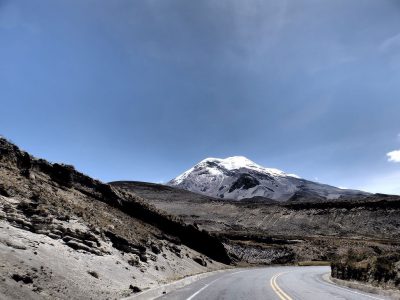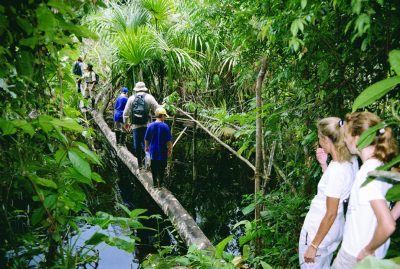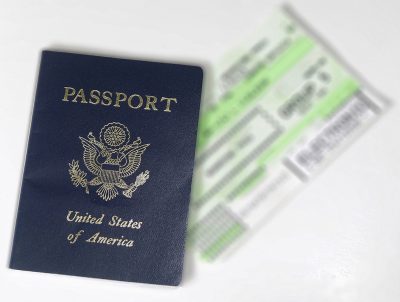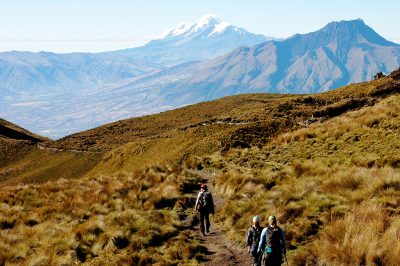Overview
 Although Ecuador, next to Uruguay, ranks among the smallest countries of South America, for Eco-travelers it is probably one of the most rewarding and popular travel destinations. Ecuador’s compact size makes travel reasonably easy, allowing travelers to see more of its widely varying eco-systems in their precious little time. Due to the hugely contrasting topography between the jungle, the highlands and the sea – not to forget the incomparable Galapagos Islands, Ecuador is regarded as one of the most species-rich regions in the world.
Although Ecuador, next to Uruguay, ranks among the smallest countries of South America, for Eco-travelers it is probably one of the most rewarding and popular travel destinations. Ecuador’s compact size makes travel reasonably easy, allowing travelers to see more of its widely varying eco-systems in their precious little time. Due to the hugely contrasting topography between the jungle, the highlands and the sea – not to forget the incomparable Galapagos Islands, Ecuador is regarded as one of the most species-rich regions in the world.
Ecuador can be roughly divided into three distinct regions: the coast, the mountains, and the jungle.
The Sierra
In the northern part of the country, surrounded by snow-topped mountains, lies Quito, the capital of Ecuador, which once stood as the northern capital of the ancient Inca kingdom. It is a picturesque and pleasant town with an agreeable climate. It makes a perfect travel base for exploring the eastern, montane rainforest covered slopes of the Andes, as well as for treks into the volcanic highland Sierra itself. Like a chain of beads, a line of volcanoes lines the highway known as ‘Avenue of the Volcanoes’, which also links all the most important highland towns, surrounded by a patchwork of fields that drape the foothills, forming the agricultural heartland of Ecuador.
The Jungle
East of the Sierra the Andes slope down to the Amazon Basin, their flanks clad in cloud forest, considered one of the top biodiversity hotspots in the world. Its many endemic birds and butterflies can be observed relatively easily here. The dense and steamy jungle of the Amazon Basin is home to many indigenous communities who try to maintain their traditional lifestyles, even in the face of encroaching oil exploitation. Many tribes have embraced eco-tourism, as a means to access income and resources by means that do not destroy their homeland, while simultaneously educating visitors about their ways of life and their jungle home.
The Coast
West of the Sierra the Andes descends to the sea. The fertile alluvial plains, strewn with tropical plantations of cacao, coffee, bananas, sugar, and rice are fringed by the coastal mangrove swamps and palm-fringed beaches.
The Galapagos Islands
Last, but certainly not least Ecuador has become famous as the home of the unique habitat that inspired Darwin’s theory of evolution. Within its boundaries, although some 1000km off-shore, lie the Galapagos islands, volcanic outcrops that have never been connected to the mainland and thus are ideal habitats for studying the evolution of various species unique to these islands. The Galapagos Islands have become a Mecca for biologists and continue to attract numerous (some say far too many) nature lovers, both amateurs and professionals each year, who all come away equally enchanted by the island’s magic charm.
Ecuador has made an effort to preserve its natural diversity and there are many destinations of outstanding cultural and natural beauty to explore.
Where to stay & what to do
 Due to the compact size of this incredibly diverse country, you can do it all in one trip: visit the highlands, the rainforest, and the coast, or even go on the adventure of your lifetime by visiting the Galapagos Islands. There is a huge amount to discover, yet, travel between the different regions is easy and relatively fast. You can base yourself in the Highlands and venture to the jungle or coast from there, or plan a round trip.
Due to the compact size of this incredibly diverse country, you can do it all in one trip: visit the highlands, the rainforest, and the coast, or even go on the adventure of your lifetime by visiting the Galapagos Islands. There is a huge amount to discover, yet, travel between the different regions is easy and relatively fast. You can base yourself in the Highlands and venture to the jungle or coast from there, or plan a round trip.
In the Sierra, you can either stay in one of the picturesque colonial towns, enjoying their colorful cultural offerings or stay at one of the many beautiful old haciendas that have been converted into beautiful guesthouses exuding old-world charm.
In the ‘Oriente‘, the eastern slopes, the cloud forest eco-lodges offer fabulous opportunities to spot for various endemic birds, butterflies, and other species. In the Amazon Basin, Yasuni National Park is the best place to stay at an eco-lodge if you have the time to venture a little deeper into the forest. There are also some more accessible eco-lodges, some luxurious, some simple, but all offering superb adventures and fun. If you are the adventurous type, you might like to visit the Waorani Tribe for a culturally immerse experience. On the other hand, if you like your creature comforts while still enjoying some incredible natural and cultural adventures, how about experiencing the Amazon Basin on board a riverboat cruise.
The Ecuadorian Mainland Coast does have a few sea-side resorts, but most are not that appealing. The best area to visit along the coast is the Machalilla National Park, from where you can take excursions to La Isla de la Plata (nicknamed ‘little Galapagos Islands’) and some beautiful beaches.
If you are planning to visit the Galapagos Islands, a classic week-long cruise is still the best way to see the islands. In order to reduce the pressure on the islands, the Government has decreed that cruise ships must alter their itinerary every week, so now all yachts have an ‘A’ and a ‘B’ itinerary, which visits different places. We only offer small yachts and catamarans to decrease the impact on each site and increase the quality of the visitor experience.
An alternative to the classic cruise is the shorter ‘Island Hopping Expedition‘. Here you get a chance to visit a few islands in greater depth. Accommodations are at small hotels on the islands rather than on the boat and you are transferred from one island to another by speedboat. Obviously, this means you can’t go the distance that the cruise ships cover, but on the other hand, you have more freedom to discover the destination on your own alongside visiting the main tourist spots with a guide.
Practicalities
 Getting there
Getting there
The capital of Ecuador is Quito, which has a new, modern airport that is serviced by international flights from other South American destinations as well as by flights from the US and Europe.
The other international airport in Guayaquil, near the coast. This airport also receives international flights from Europe, the US as well as other South and Central American destinations. This airport offers the greatest number of flights to the Galapagos Islands, but it is also possible to fly there directly from Quito.
There are no international flights directly to the Galapagos Islands.
Getting Around
By air: There are domestic flights to all parts of the country and many people opt to fly to the Amazon Basin instead of making the journey by road. Most Ecuadorians travel by bus, although there is also a railway network which has recently been turned into a tourist attraction. The most famous route is the Devil’s Nose, which follows a hair raising track across rocky ravines and raging rivers. The longest route runs from Quito to Guayaquil.
By car: Although roads have for the most part vastly improved in the last decade or so, and some companies are beginning to offer self-drive itineraries, it is not recommended.
To get to the Galapagos Islands
The only destination that can only be reached by air is the Galapagos Islands. The main airports there are Baltra and San Cristobal.
Weather
What kind of weather conditions you might expect will depend much on where you are planning to go. The Sierra is at high altitude and in the mountains, you can experience any kind of weather at any time. If you are planning on doing any kind of hiking or trekking adventures, you will need fast drying, weatherproof gear, and good, sturdy hiking boots. Be prepared for cold rain and wind and cold nights. If you are trekking in the páramo make sure your boots are waterproof or have a rubber coating on the lower part.
In the cloud forest it will also be quite cool and damp, most of the time, but lower down in the Amazon it will be steamy and hot and damp. Avoid bringing leather items (no leather shoes or belts) as these don’t do well in such conditions, they will go hard and may get moldy. Bring zip-lock bags to keep things dry. Also, you’ll want to bring long-sleeved, yet light clothes to protect yourself against insects. Many jungle lodges provide rubber boots up to size 10. A light rain poncho would also be an essential item to pack.
In the Galapagos, it is usually pleasantly warm during the day, but nights can be cool. Bring sneakers for the boat and
You will find a detailed packing list for each adventure listing.
Visa Information
To get the latest visa regulations, check with the embassy. However, as is always necessary to bring a passport that will remain valid for at least 6 months after your trip to Ecuador. You must also have a return ticket to your country of origin or an onward ticket elsewhere.
Before entering the country you will have to fill in an international visitor card, which you must hold onto during the duration of your stay. You will have to hand it in again upon leaving the country.
Money
Ecuador uses the US dollar. Bring small denomination bills as it is hard to break larger ones. ATMs and credit cards are now more widely used in towns and at restaurants, tourist facilities, and shops, but cash is king for everyday purchases.
Time
Ecuador (except Galapagos) is in the same time zone as New York.
Language
Spanish is the official language but there are many indigenous languages spoken as well. Some people, especially in the tourist areas, will be able to speak English.
Electricity
Ecuador uses 110 volts, 60-Hz cycle, same as the US. Most plugs are the flat, two-pronged types, (same as the US) but some older sockets may have 3 prongs, but the US type rather than the UK type. UK visitors will need to bring an adaptor for their electrical equipment.
National Parks & Protected Areas
 Ecuador ranks among the more eco-conscious countries of Latin America and there are many national parks, nature reserves and protected areas throughout the country. Some can be visited and have facilities for camping and hiking. The ones listed below are just a small selection.
Ecuador ranks among the more eco-conscious countries of Latin America and there are many national parks, nature reserves and protected areas throughout the country. Some can be visited and have facilities for camping and hiking. The ones listed below are just a small selection.
Cotopaxi
Cotopaxi is the highest active volcano in the world. Covered handsomely with permanent snow-caps on top of the crater, several nearby lakes and streams are ideal sites for observing the local avifauna. Located in Cotopaxi Province, 44 miles from Quito, it contains 82,514 acres. There are camping sites, footpaths and basic tourist infrastructure.
Sangay
This 669,653-acre park is located in Morona-Santiago and Chimborazo provinces, 174 miles from Quito. There are camping sites and places to sleep, as well as basic tourist infrastructure. Sangay is an active volcano and large areas of the park have been formed by recent eruptions. Two other active volcanoes are located in the area: Altar and Tungurahua. Both are suitable for mountain climbing. The area supports several ecosystems, from the snow and alpine zones to humid, subtropical forest. Plant observation is very interesting and varied, especially in transition areas.
Machalilla
A coastal park equipped with basic tourist infrastructure located 310 miles from Quito. 135,905 acres of Manabi Province have been dedicated to this park. The landscape is composed of beaches and sea steppes, bays and coastal forest. There are a lot of archaeological sites on the coast, as well as on La Plata, Ahorcado and Salango Islands. There are small anthropological museums on Salango and Agua Blanca. Vegetation takes on three different forms: rain forest, dry forest, and very dry forest. The most notable plant species are cecropia, balsa, ecus,
Yasuni
Located in Napo Province, the western limit of Yasuni is only 190 miles from Quito. The park, which has camping sites, extends for 1,679,643 acres. This biosphere reserve is Ecuador’s most bio-diverse area. The Huaorani Indian tribe lives in the Tiputini, Yasuni, Cononaco, and Nishino river basins, as well as on lagoon shores and navigable streams. There are many types of vegetation, e.g., riparian, flooded forest or
Podocarpus
Montane cloud forest park in the province of Loja and Zamora Chinchipe extending over 146,280 acres over a high mountain river basin. Temperate humid zone with coniferous vegetation.
Galapagos
There is no doubt that the islands are a true living laboratory for the scientists of all times. This sanctuary of wildlife and volcanoes lies about 1.000 Km off the coast of continental Ecuador and is composed of 13 islands and dozens of islets and reefs: a refuge for a plethora of endemic species. See the UNEP information about the Galapagos
WORLD HERITAGE SITE
1983 Sangay National Park Situated in the central Andes this park is the largest area of unaltered wild land in the country’s eastern Cordilleras. It has outstanding natural beauty, two snow-capped active volcanoes and an entire range of ecosystems from the tropical rainforests of the Amazon basin to mountain glaciers. Its isolation has contributed to protecting a wide range of species including endemic ones, such as the mountain tapir and Andean condor.
